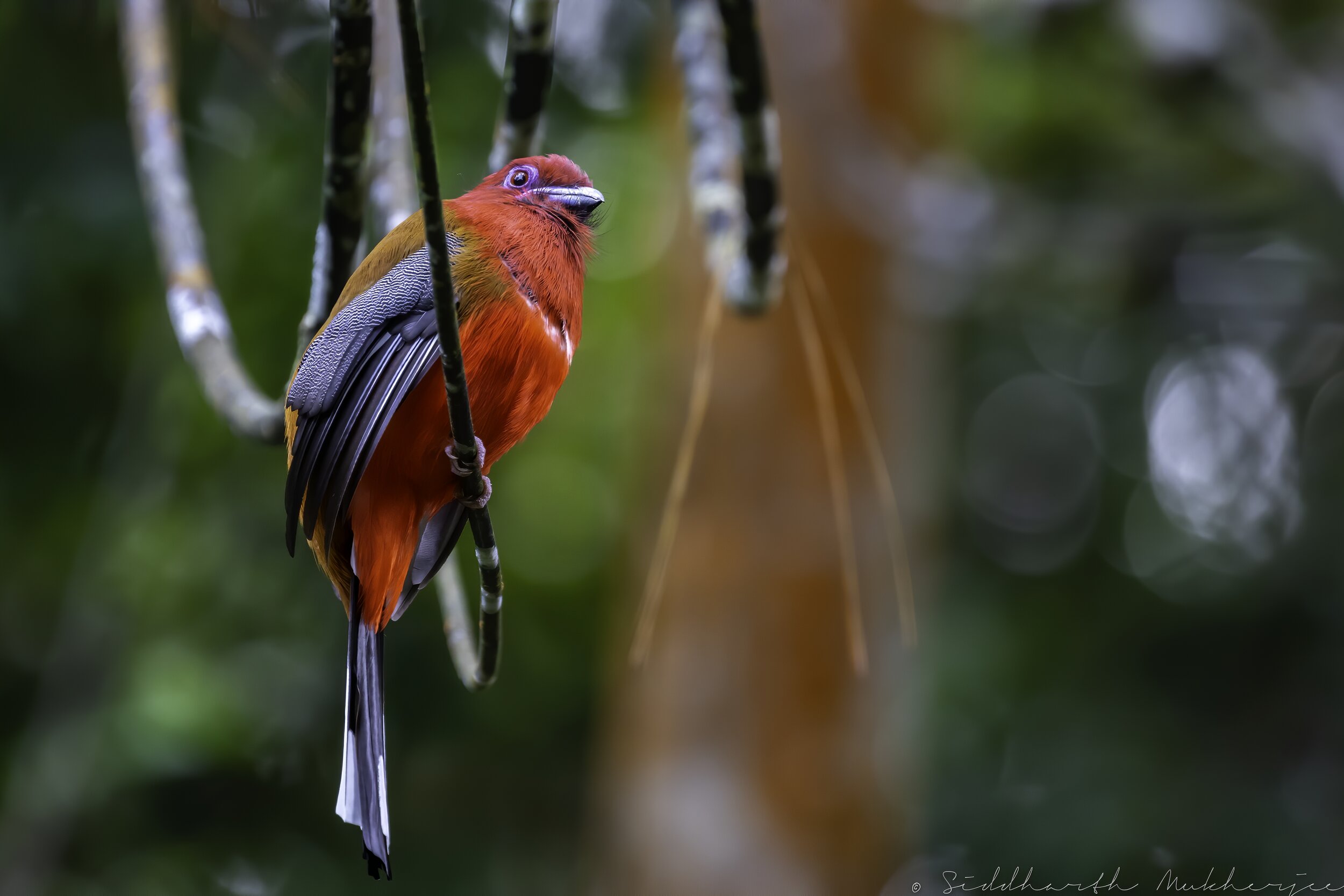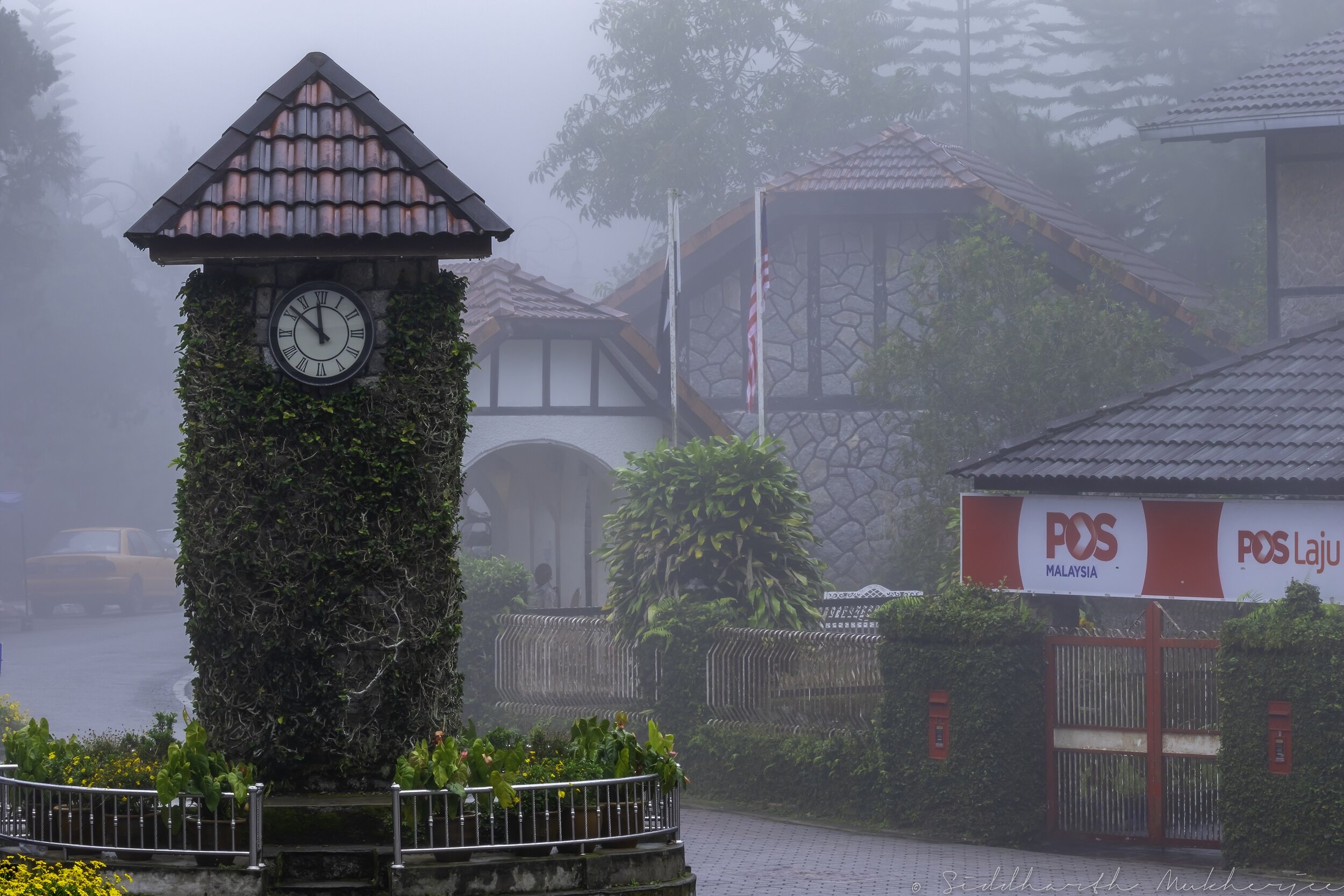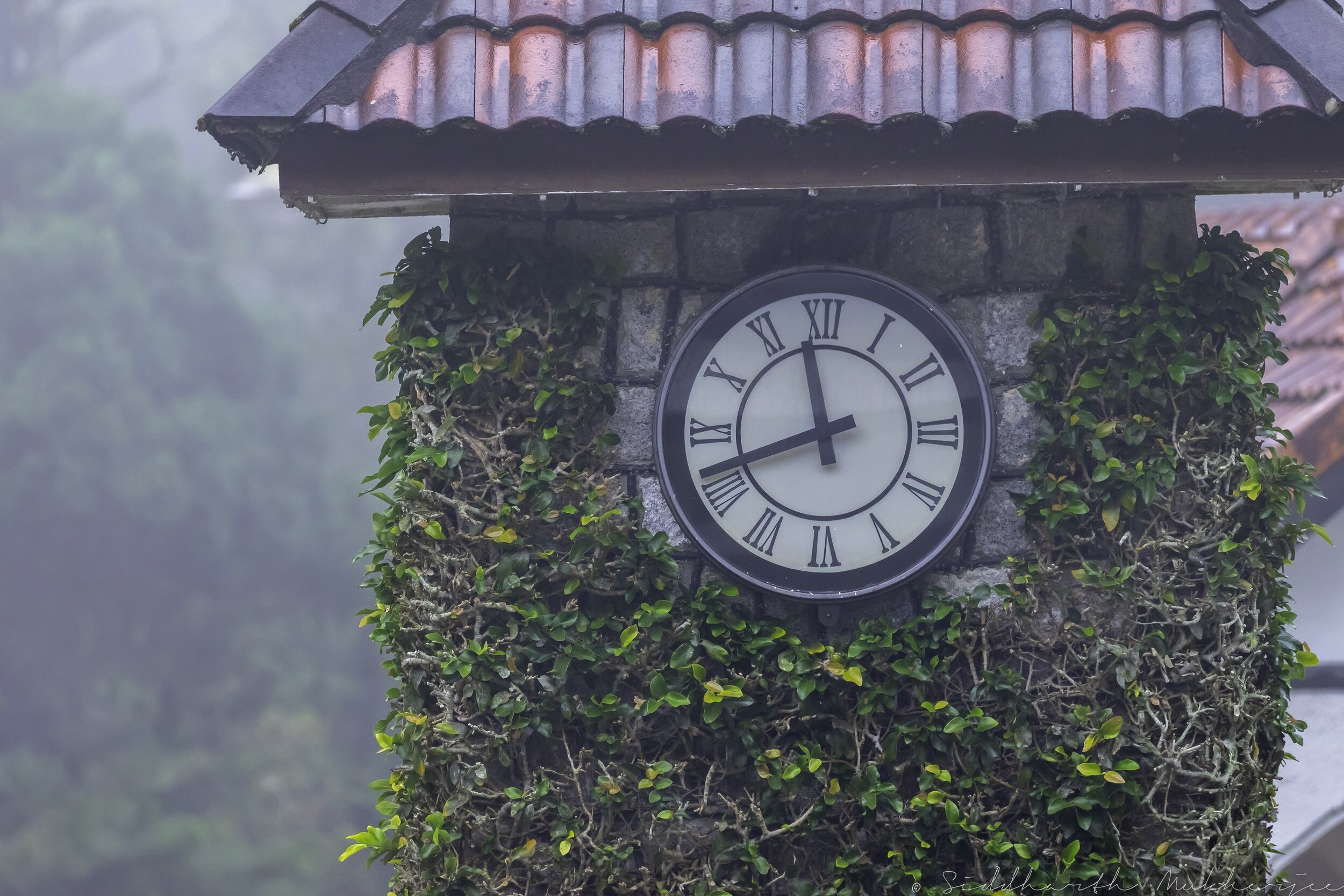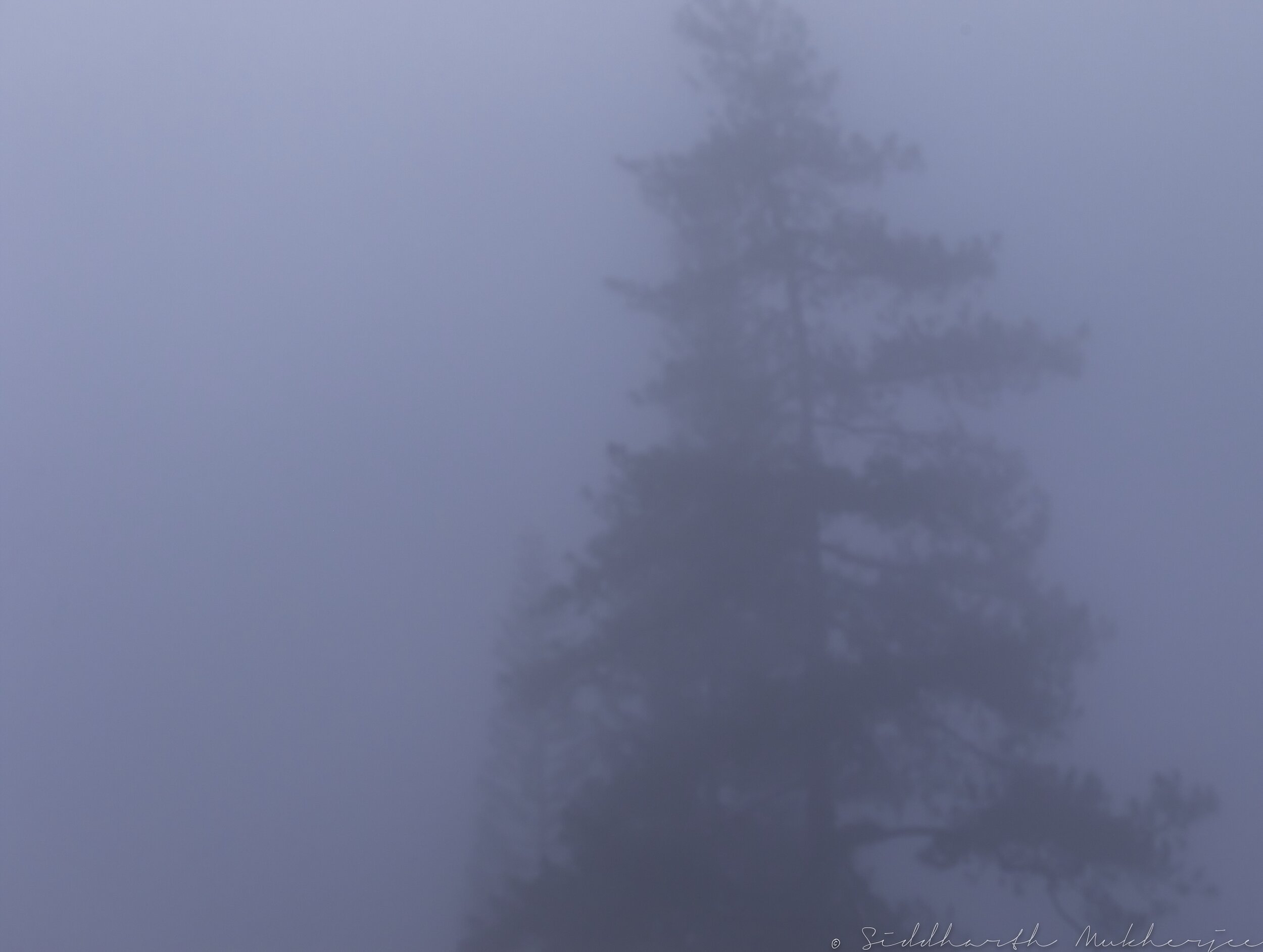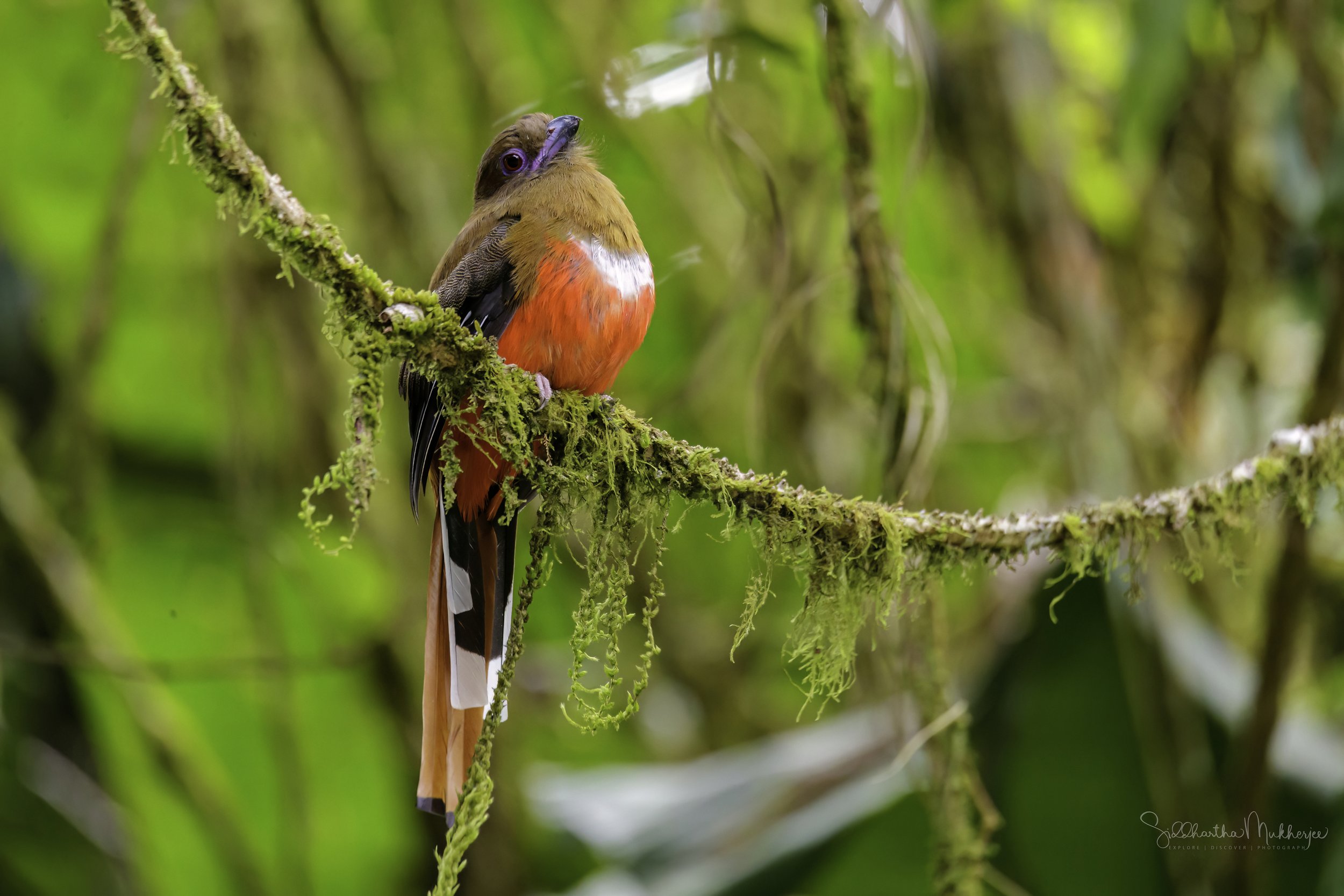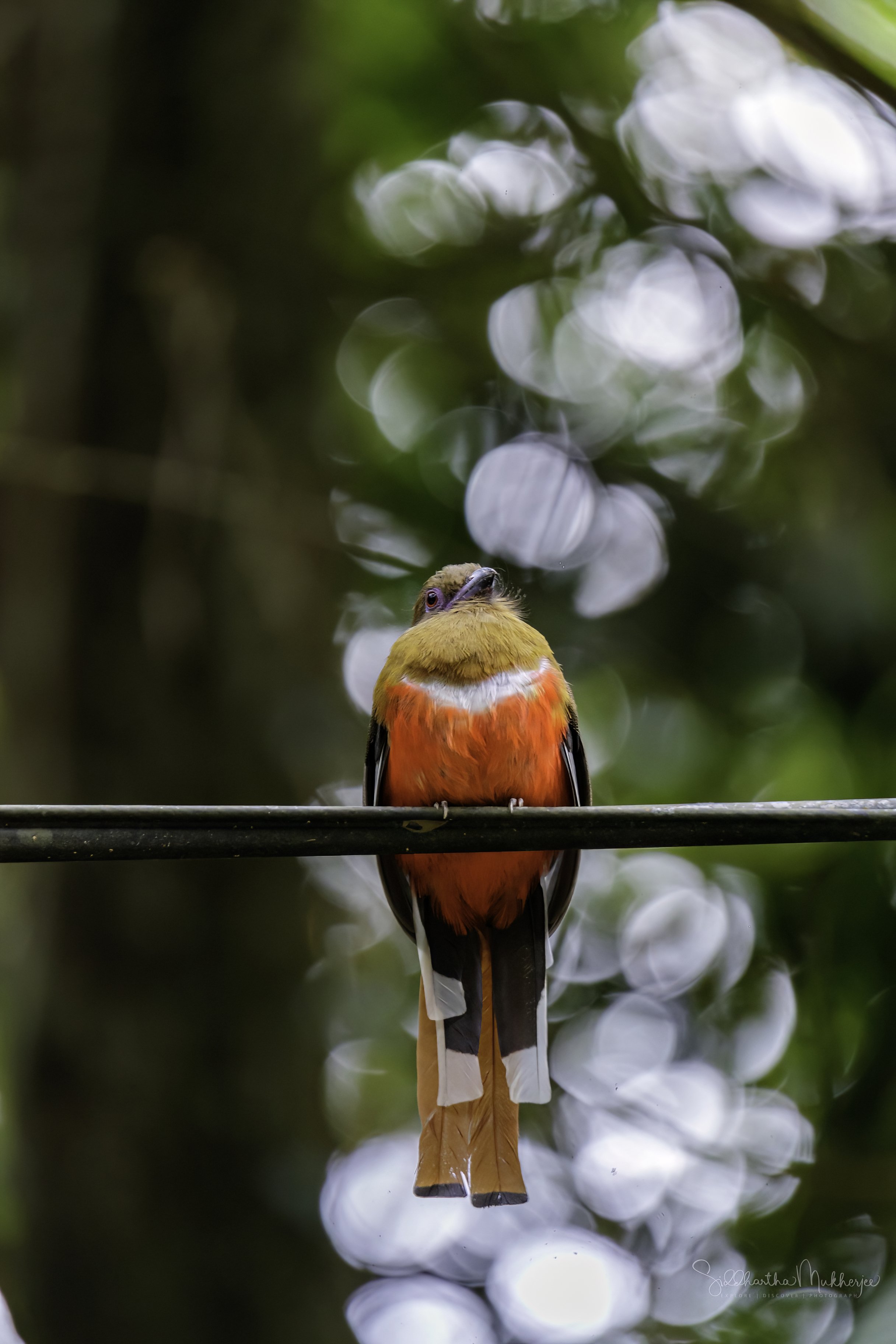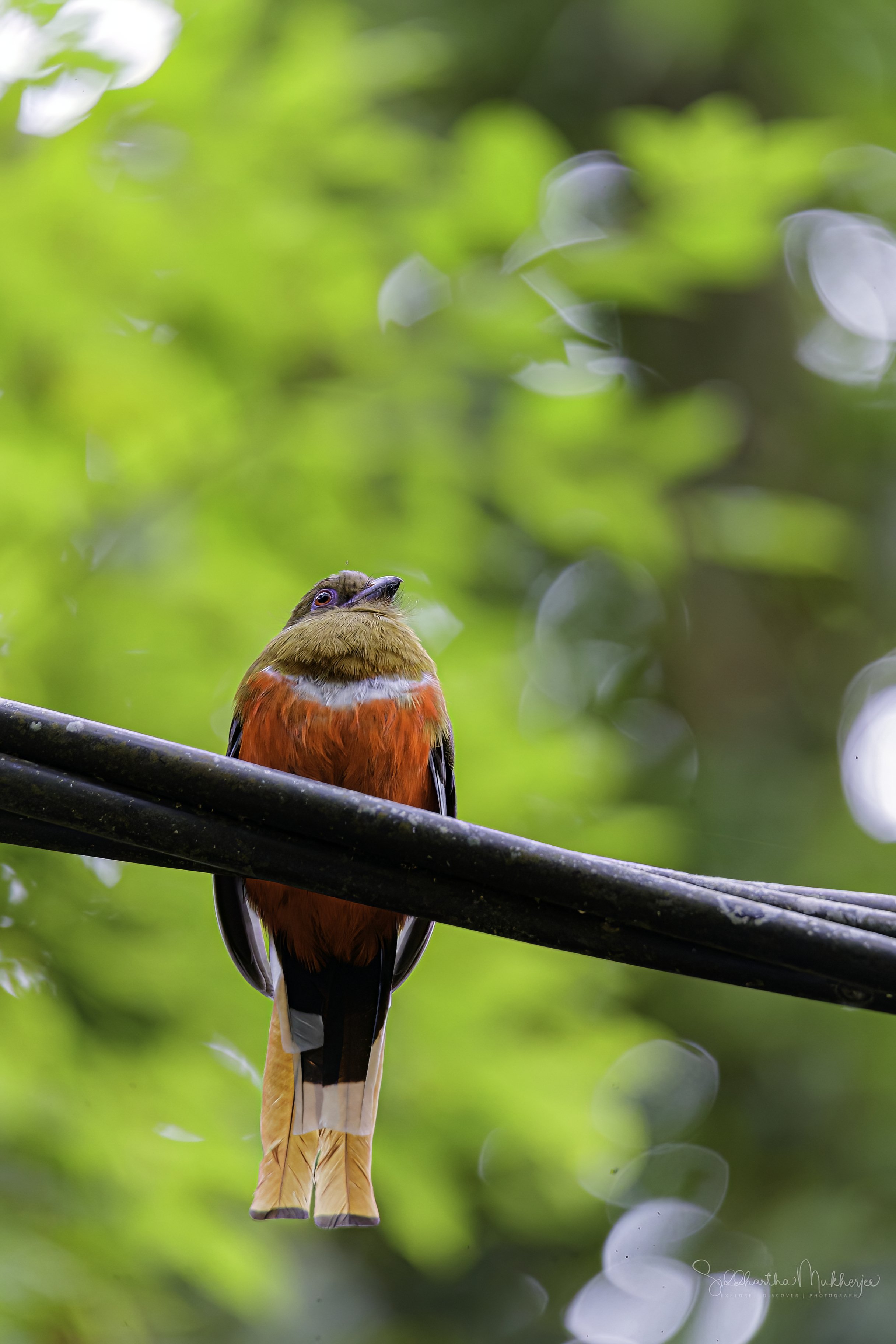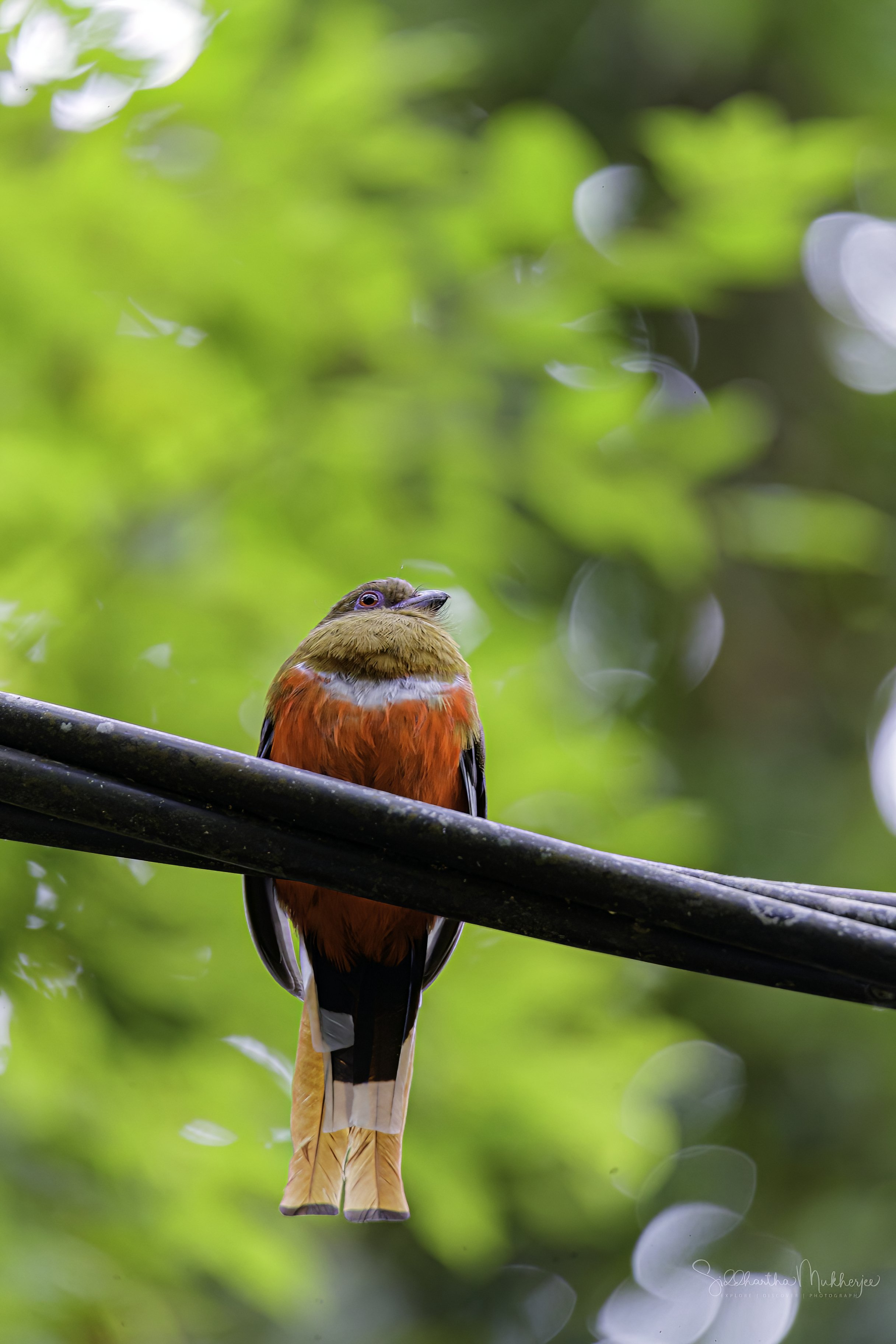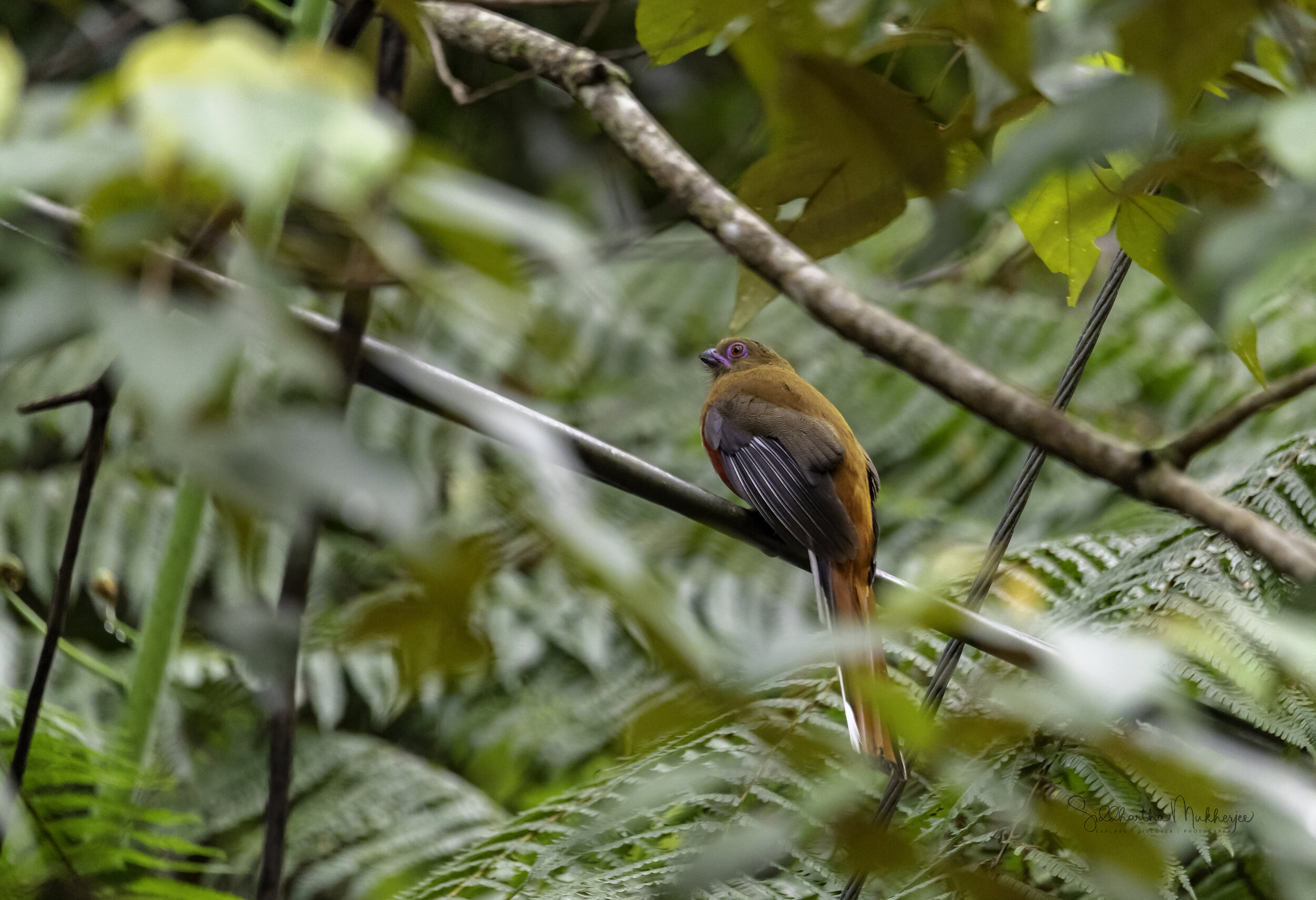Red-headed Trogon
Harpactes erythrocephalus
Bukit Fraser, Malaysia
The Red-headed Trogon (Harpactes erythrocephalus) is a brightly coloured bird of dense evergreen forests, usually seen perched quietly on a mid-story perch. It varies in coloration throughout its range but always follows the same general color scheme with the male with a dark red head & belly, a brown back, and barred black-and-white wings. The female has a brown head and a faded-red belly. Both sexes, when seen from below, have a sharply contrasting and graduated black-and-white tail pattern as can be seen in my photos here. It is a sluggish and shy bird typically stationary and difficult to see. The best way to spot it is to listen for its high-pitched gulping hoots.
Interestingly I have also noticed that it seems to maintain a time table of sorts. I have spotted the red-headed trogon at Bukit Fraser and every time we made sure we got to the location around the same time and invariably the bird would show up when it was expected and perch on more or less the same places while it foraged. Sometimes it would fly left and sometimes to the right but more often than not it would fly along the same routes each time. After the first couple of times it got quite easy to track and predict where it would perch and get the frame we were looking for. The only catch was that it was always at a mid story perch so one would always be looking up at it.
But first about Bukit Fraser - one of my favourite destinations in Malaysia. Bukit Fraser or Fraser's Hill is a hill resort located on the Titiwangsa Ridge in the Raub District of Pahang, Malaysia. It is about 100 km, about a two hour drive, from the capital Kuala Lumpur and 400 km away from Singapore in the south. Known locally as Bukit Fraser, this quaint holiday retreat is popular for its nature activities and cool weather. It is one of the last hill stations of Malaysia carrying an imprint of its former British colonial masters very similar to some of the well known hill stations (winter capitals) of India.
Fraser's Hill is mountainous terrain where the altitude ranges between 320 m (1,050 ft) and 1,460 m (4,790 ft) above sea level. Around 44% of the terrain area is ranked as steep, while flat areas make up 8% of the overall land area. Fraser's Hill's virgin forest coverage is around 92% of the overall land area, with only 1.5% of the area used for a town. 6.5% of the forest area has been cleared for secondary vegetation. Ten river systems in Malaysia originate in Fraser's Hill, including Sungai Selangor, a major water source for the district of Selangor, and Sungai Teranum, which forms a major river system in eastern Pahang. The geology of the area is predominantly granite, which forms sandy, permeable soil and is easily eroded.
Fraser’s Hill has its roots in the 1890s, when Scottish prospector Louis James Fraser opened up a tin mining community known as Pamah Lebar. Mining activity there was short lived as the tin ore depleted by 1913. This led many miners and farmers to abandon the area and Fraser reportedly disappeared in 1910, but research in 2019 concluded that he retired from his position and returned to Great Britain in 1910. He died in 1916 while travelling in Austria-Hungary. An attempt in 1917 by Charles James Ferguson-Davie, the then bishop of Singapore, to locate Fraser in the area failed. While he searched for Fraser, Ferguson -Davie recognized the area's potential as a suitable location to set up a hill station and provided his suggestions to the high commissioner and chief secretary of the Federated Malay States. Its cool climate made Pamah Lebar an ideal retreat to escape from the usually hot climate in Malaysia and construction began in October 1919 to convert the mine area into a resort. The site was renamed Fraser's Hill and opened to visitors in 1922 and the erstwhile location of Fraser’s tin mine became the location of its golf course.
Subsequent development occurred in the 1970s in response to increased tourism activity. While this provided room for more visitors, it had an impact on the environment including deforestation and water pollution prompting a halt to further developments in April 2010. More species faced extinction and the water pollution affected the lives of the Orang Asli (first people) and residents in nearby villages. These issues led to the Pahang state government ruling out further development in the virgin forest at Fraser's Hill on 13 April 2010.
Fraser's Hill is known for its vast biodiversity which attracts scientists and researchers. In recent years, it has seen an increase in tourist activities including hiking, cycling, golfing, archery, riding, tennis, swimming and squash. With its tiny population of 1,000, as recorded in 2013, it is one of Malaysia’s most unexpectedly satisfying short-stay destinations. Navigating up the tight twists and turns of the road to this hill station is a stimulating experience – in fact the uphill road is so narrow that the final eight kilometre stretch is limited to one-way traffic at any time. The direction changes every hour; odd hours are for ascending the hill, while even hours have been denoted for descending traffic. With a majority of its buildings featuring mock Tudor-style architecture, Fraser’s Hill hasn’t changed much from its days as a British colonial hill resort. Besides the essential photo stop opportunity at Fraser’s Clocktower, a hard-to-miss clock tower which stands in the old English village square, you can head on down to Allen’s Water, a former reservoir turned into a boating and fishing attraction.
Akin to a tiny Scottish hamlet, Fraser’s Hill is one of Malaysia’s premier locations for bird-watching. Avid bird watchers can take advantage of the fact that Fraser’s is home to over 250 species of birds – the Fraser’s Hill Development Corporation and the World Wildlife Fund both run classes and excursions to see the flora and wildlife of the hill station. What's more, the Fraser’s Hill International Bird Race – a contest to document the vast variety of birdlife on the mountainside – is typically held here in June. There are eight nature walk trails available ranging from easy to hard. For example the Maxwell Trail – a short and easy hike or the six-kilometre Pine Tree Trail – a longer trail that takes one past some dramatic views and ends near the 18 foot Jeriau Waterfall located about five kilometres from the town centre. Fraser’s also plays host to the Royal Fraser’s Hill Golf Course – a nine-hole green that is one of Malaysia’s oldest. There’s also a paddock at the eastern edge of the course where one can saddle up for a horse riding session.
With that said, meet the first of my birds from Fraser’s Hill - the Red-headed Trogon. We spotted the trogon and his mate near the Bishop’s trail and usually between 7 and 7.30am. The Red-headed Trogon (Harpactes erythrocephalus) is a species of bird in the family Trogonidae. It is on average 34 cm (13 in) in length. The male has a red head and breast, a unique feature in the Trogon group while the female resembles the Diard's trogon without a speckled undertail, a brown head and a faded-red belly.
‡‡‡‡‡
Red-headed Trogon
The head, neck and upper breast of an adult male is dull crimson. A narrow white band crosses the mid breast, underneath which the lower breast to abdomen is light red to pink. Pale red can be observed on the flanks whereas the mantle and back of the bird are rusty brown. The male perches on branches with the support of mauve-blue legs. Regarding wing colouration, the lesser and median wing coverts, secondary coverts, as well as outer webs of tertials and secondaries are vermiculated black and white. The primary feathers also appear black and white. As for the bird's long tail, the central feathers are dark brown with a black tip, the second and third pairs are black and the outer pairs are white with black bases. Finally, a black-tipped cobalt blue bill, a deep mauve-blue gape and eyering and reddish-brown irises shape the bird's face.
The head, neck and upper breast of an adult female are olive-brown. Just like the male, a narrow white band crosses the mid breast, underneath which the lower breast to abdomen is light red to pink. The mantle and back appear orange to brown in colour. The wings are vermiculated dark brown and yellowish brown. The tail feathers are very similar to those of the males. The bill, gape and bare eyering are pale blue on females.
These trogons are widely distributed from central Nepal, Southeast Asia, southern China to Sumatra. It is fairly common in northeastern India, frequent in Bhutan, and locally dispersed in Bangladesh. It prefers upland forests and lives in dense broadleaved forests and in tropical and subtropical zones in the Himalayan foothills. In Southeast Asia, it frequents broadleaved evergreen forests from 300 to 2,600 m (980 to 8,530 ft) and on the Malay Peninsula, it inhabits evergreen lowland, lower montane and taller upper montane forests at elevations ranging from 300 to 1,680 m (980 to 5,510 ft).
I’ve always see the red-headed trogon perching on shaded branches waiting for prey, mostly alone and a couple of times in pairs. Its flight between trees is often sluggish and very low, only a few meters above the ground. It is most active in the early morning hours and at night, when it pursues its favourite prey - moths - at the edges of forest clearings. They feed primarily on insects and their larvae, including green orthopterans, stick-insects, cicadas, millipedes, flies, beetles, centipedes, woodlice and moths. It also feeds on leaves and fruits.
The male's call resembles that of the Eurasian golden oriole (Oriolus oriolus): a sequence of usually five to six, well-spaced mellow “tyaup” notes, repeated every minute. Occasionally the male calls an extended “pluu-du” note marked by a significant terminal drop in pitch. The call is repeated every 3–6 seconds.
The following gallery is of the red-headed trogon - both male & female - observed & photographed near the Bishop’s trail at Bukit Fraser. The photos are from various trips I have made to this quaint little village town.
‡‡‡‡‡
Calls of the Red-headed Trogon recorded at Bukit Fraser.
‡‡‡‡‡
Related Posts

